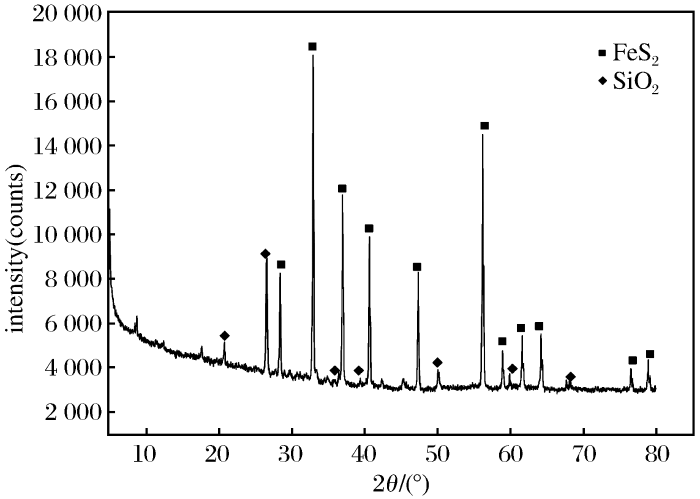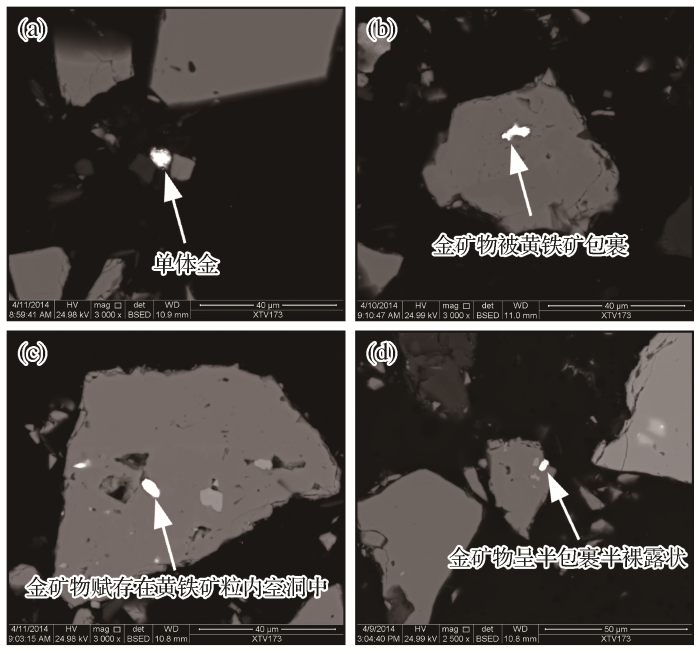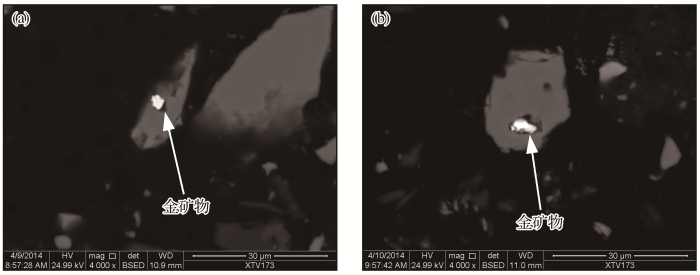难处理金矿是指经细磨后未经某种形式预处理,无法应用常规氰化工艺将矿石中大部分金有效提取出来的金矿石,一般指细磨后氰化浸出率低于80%的金矿石,典型的难处理金矿直接浸出率仅为10%~30%[5,6,7,8,9,10]。根据矿物特点,可将难处理金矿划分为含砷金矿、碳质金矿、磁黄铁矿型金矿、碲化物和硫盐型金矿、难浸硅质金矿以及硫化铅和硫砷铜矿型金矿等[11,12,13,14,15,16,17],其中高硫矿是我国最常见的难处理金矿[18,19]。难处理金矿经细磨重选或浮选得到的金品位大于10×10-6的富集矿物即为难处理金精矿[20,21]。其中,高硫型金精矿的矿物组成很复杂,金常被包裹于其他矿物中,处理难度较大。目前已有一些学者开展了高硫型难处理金精矿的工艺矿物学研究。丁文涛等[22]利用矿物解离度分析仪对某金精矿进行工艺矿物学研究,发现细磨可以使部分硫化矿包裹的金解离,但其分析手段单一,未能解释各物相赋存状态及金的包裹形式等。高国龙等[19]采用化学成分分析、X射线衍射分析、矿物解离度分析和扫描电镜—能谱分析等方法开展了某金矿物的工艺矿物学研究,发现该金精矿为典型的高硫高砷难浸复杂金矿,金精矿中的主要金属矿物为毒砂和黄铁矿,脉石矿物主要有石英和白云母,且矿石中多种矿物互相包裹,但未能解析金的解离度以及被包裹的形式。
本文以陇南紫金高硫型难处理金精矿为研究对象,开展金矿石的工艺矿物学研究,通过对矿物组分、各物相赋存状态和金的伴生规律进行深入分析,为高硫难处理金精矿提金工艺选择提供理论依据。
1 试验原料与方法
1.1 试验原料
试验所用的金精矿取自陇南紫金有限公司选矿厂,经丁基黄药和丁铵黑药组合药剂浮选得到,对试验样品进行混均、缩分和取样。开展粒度-0.074 mm占89.4%的金精矿氰化浸金试验,金的氰化浸出率仅为53.78%,属于难浸金精矿。为有效提高该金精矿金的氰化浸出率,采用化学成分分析、X射线衍射分析、矿物解离度分析和扫描电镜—能谱分析等技术手段开展金精矿的工艺矿物学研究。
1.2 测试方法
(1)多元素分析。采用化学滴定分析法、DGS-III型原子发射光谱仪(中国泰伦)和WFX-120B原子吸收分光光度计(中国瑞利)分析金精矿的元素组分。
(2)X射线衍射分析。采用X’ Pert Pro MPD型X射线衍射仪(荷兰Philips)测定金精矿物相组成,铜靶,测量范围为0~80°。
(3)矿物解离度分析。采用矿物解离度分析仪(FEI.Quanta 600.JKtech MLA suite)的SPL-XBSE模式分析金精矿矿物组成和含量。
(4)扫描电镜—能谱分析。采用Nova 400 Nano SEM型扫描电镜(美国FEI)和 INCAIE350型X射线能谱仪(英国牛津)对金精矿进行X射线扫描微区分析,测试时加速电压为25 kV,放大倍数为3 000~5 000,工作距离为10.8~11.0 mm。
2 结果与讨论
2.1 金精矿化学组成分析
对金精矿进行多元素分析,结果表明:该金精矿中Au和Ag的质量分数分别为18.64×10-6和18.00×10-6,S和As的质量分数分别为42.12%和2.31%,属于典型的高硫、高砷金精矿(表1)。此外,该金精矿还含有Cu、Pb、Zn等金属及有机碳,在氰化浸出过程中,这些成分会与氰化药剂作用,额外消耗氰化物,恶化浸金效果。
表1 陇南紫金金精矿多元素分析结果
Table 1
| 元素 | w(B)/% | 元素 | w(B)/% | 元素 | w(B)/% |
|---|---|---|---|---|---|
| Au* | 18.64 | MgO | 0.62 | Cu | 0.051 |
| As | 2.31 | Ag* | 18.00 | Pb | 0.20 |
| TS | 42.12 | SiO2 | 11.42 | Cr | 0.008 |
| CaO | 0.47 | Al2O3 | 3.20 | 有机碳 | 0.14 |
| Fe | 36.04 | Zn | 0.18 | ||
| TC | 0.40 | Cd* | 0.20 |
2.2 金精矿物相分析
图1
图1
陇南紫金金精矿XRD分析结果
Fig.1
XRD analysis results of a gold concentrate in Longnan Zijin
表2 金精矿中硫物相分析结果
Table 2
| 硫物相 | 含量/% | 占比/% |
|---|---|---|
| S6+ | 0.14 | 0.34 |
| S2- | 39.08 | 93.96 |
| 其他硫 | 2.37 | 5.70 |
| 总硫 | 41.59 | 100.00 |
2.3 金精矿矿物组成分析
对浮选金精矿原粒度样品进行分级,得到+0.075 mm(产率14%)、-0.075 mm~ +0.045 mm(产率26%)和-0.045 mm(产率60%)3个粒级的样品,分别对每个粒级进行矿物组成与含量分析,结果如表3所示。
表3 金精矿矿物组成与含量
Table 3
| 矿物名称 | 矿物在原矿和不同粒级金精矿中的质量分数 | |||
|---|---|---|---|---|
| 原金精矿样 | +0.075 mm | -0.075~+0.045 mm | -0.045 mm | |
| 合计 | 100.00 | 100.00 | 100.00 | 100.00 |
| 黄铁矿 | 79.60 | 63.83 | 80.34 | 82.95 |
| 毒砂 | 3.80 | 1.77 | 2.48 | 4.85 |
| 黄铜矿 | 0.12 | 0.03 | 0.04 | 0.18 |
| 黝铜矿 | 0.02 | 0.01 | 0.01 | 0.03 |
| 闪锌矿 | 0.35 | 0.28 | 0.27 | 0.40 |
| 方铅矿 | 0.12 | 0.09 | 0.11 | 0.14 |
| 赤铁矿、褐铁矿 | 0.08 | 0.14 | 0.10 | 0.05 |
| 自然金、银金矿 | 微量 | 微量 | 微量 | 微量 |
| 石英 | 9.69 | 23.57 | 10.93 | 5.91 |
| 绢云母 | 5.24 | 8.37 | 4.18 | 4.97 |
| 长石 | 0.08 | 0.10 | 0.20 | 0.02 |
| 碳酸盐 | 0.87 | 1.67 | 1.29 | 0.50 |
| 磷灰石 | 0.03 | 0.13 | 0.06 | - |
由表3可知,该矿石具有矿物组成复杂、矿物种类多、金属矿物含量高和非金属矿物含量低的特点。该金精矿中的金矿物主要是自然金和银金矿。金属矿物主要是黄铁矿和毒砂,含少量的黄铜矿、黝铜矿、闪锌矿、方铅矿、赤铁矿和褐铁矿。脉石矿物主要为石英和绢云母,含少量的长石、碳酸盐和磷灰石。与原样矿物含量对比可知,精矿粒度由+0.075 mm降至-0.045 mm时黄铁矿和毒砂的含量分别由63.83%和1.77%提升至82.95%和4.85%,而石英和绢云母的含量分别由23.57%和8.37%降低至5.91%和4.97%,由此可知再磨有利于金属矿物的富集以及脉石的分离。
2.4 金属矿物粒度、解离度及嵌布规律分析
表4 金精矿中黄铁矿和毒砂的粒度分布
Table 4
| 粒级/mm | 占比/% | |
|---|---|---|
| 黄铁矿 | 毒砂 | |
| 合计 | 100.00 | 100.00 |
| +0.075~-0.147 | 1.45 | - |
| +0.044~-0.075 | 19.99 | 7.63 |
| +0.02~-0.044 | 32.07 | 34.12 |
| +0.01~-0.02 | 24.19 | 30.82 |
| -0.01 | 22.29 | 27.43 |
表5 金精矿中黄铁矿、毒砂解离情况
Table 5
| 矿物名称 | 占比/% | |||
|---|---|---|---|---|
| 解离单体 | 与毒砂连生 | 与脉石连生 | 与黄铁矿连生 | |
| 黄铁矿 | 85 | 0.6 | 14.4 | - |
| 毒砂 | 75 | - | 15 | 10 |
图2
图2
金精矿中黄铁矿与脉石、毒砂连生情况
(a)自形黄铁矿与脉石连生;(b)他形黄铁矿与脉石连生;(c)碎屑状黄铁矿与毒砂;(d)黄铁矿与自形毒砂连生
Fig.2
Pyrite associated with gangue and arsenopyrite in a gold concentrate
(3)石英。石英是矿石中含量较多的一种脉石,分布较为普遍,呈不规则粒状、块状和带状结构,常与鳞片状绢云母共生,与黄铁矿和毒砂形成简单嵌布关系。
(4)绢云母。绢云母呈鳞片状和板状结构,常与石英共生,还可与黄铁矿和毒砂形成简单的嵌布关系。
2.5 金矿物特征分析
陇南紫金金精矿中的金矿物为微粒金,粒度分布较均匀,在1~10 μm之间(表6)。金矿物中金的质量分数为74%~89%,银为9%~23%,铁为1%~9%,基本不含其他元素。金矿物以银金矿为主,占比为86.67%;此外,还有少量的含银自然金,占比为13.33%(银金矿中金质量分数在50%~85%之间,含银自然金中金质量分数大于85%)。
表6 金矿物粒度及能谱成分
Table 6
| 金颗粒序号 | 粒度/μm | 成分及其质量分数/% | ||
|---|---|---|---|---|
| Au | Ag | Fe | ||
| 1 | 2.5×0.6 | 81.39 | 14.07 | 4.54 |
| 2 | 2.2×1.2 | 79.95 | 13.39 | 6.66 |
| 3 | 8.5×1.2 | 74.30 | 22.85 | 2.85 |
| 4 | 8.1×2.1 | 81.63 | 15.05 | 3.32 |
| 5 | 2.5 | 83.50 | 12.76 | 3.74 |
| 6 | 2.0×3.0 | 78.77 | 15.60 | 5.63 |
| 7 | 2.0×1.3 | 75.97 | 22.96 | 1.07 |
| 8 | 4.5 | 76.96 | 21.21 | 1.83 |
| 9 | 6.0×3.0 | 80.44 | 17.06 | 2.50 |
| 10 | 2.3 | 78.72 | 17.94 | 3.34 |
| 11 | 4.0×3.0 | 82.50 | 15.39 | 2.11 |
| 12 | 3.0×1.6 | 80.38 | 11.93 | 7.69 |
| 13 | 6.0×2.5 | 76.13 | 15.66 | 8.21 |
| 14 | 4.3 | 85.81 | 11.26 | 2.93 |
| 15 | 3.7×2.0 | 88.06 | 9.21 | 2.74 |
图3
由金的物相分析结果可知,金精矿中裸露金占比为39.21%,与镜下观测结果相符。硫化物包裹金占比为56.19%,氧化物及碳酸盐包裹金占比为3.94%,硅酸盐及其他包裹金占比为0.66%,总包裹金占比达60%左右,属于硫化物包裹难处理金精矿(表7)。
表7 金化学物相分析结果
Table 7
| 项目 | 质量分数/(×10-6) | 占比/% |
|---|---|---|
| 总金 | 18.26 | 100.00 |
| 裸露金 | 7.16 | 39.21 |
| 氧化物和碳酸盐包裹金 | 0.72 | 3.94 |
| 硫化物包裹金 | 10.26 | 56.19 |
| 硅酸盐和其他包裹金 | 0.12 | 0.66 |
2.6 不同粒度金精矿中金矿物的特征
将金精矿分别磨细至-0.045 mm占80%和93.4%,并分析金的解离度和嵌布特征(图4)。结果显示:-0.045 mm占80%和93.4%的金精矿样品中均存在12颗金矿物,呈不规则形态,其单体解离度分别为37%和62%,未解离的金矿物全部与黄铁矿连生,呈半包裹半裸露状或完全被包裹状,且包裹金常赋存于黄铁矿颗粒内的孔洞中。
图4
图4
不同粒度的金精矿电镜扫描图
(a)-0.045 mm占80%的金精矿;(b)-0.045 mm占93.4%的金精矿
Fig.4
Scanning electron microscopy of gold concentrates with different particle sizes
综合-0.075 mm占80%、-0.045 mm占80%和-0.045 mm占93.4%的金精矿中金矿物特征分析可知,该样品中的金矿物主要与黄铁矿连生,易被黄铁矿包裹或半包裹,包裹金常赋存于黄铁矿颗粒内部的孔洞中,经再磨较易解离成单体金。经金精矿的再磨,金矿物的单体解离度由原来的37%提升至62%,即精矿再磨有利于金颗粒的解离或暴露,从而使金颗粒在后续浸出过程中与浸金试剂充分接触,提升金的回收率。
3 结论
(1)陇南紫金金精矿S、As元素的质量分数分别为42.12%和2.31%,硫化物包裹金占比为56.19%,属于硫化物包裹难处理金矿。
(2)该金精矿中的主要金属矿物为自然金、银金矿、黄铁矿和毒砂,主要脉石为石英和绢云母,其中黄铁矿是金矿物的主要载体。
(3)金矿物粒度为1~10 μm,金矿物中Au质量分数为74%~89%,Ag质量分数为9%~23%,金矿物以银金矿为主,存有少量自然金。
(4)金矿物的单体解离度为30%,未解离的金矿物均与黄铁矿连生,呈半包裹半裸露状或完全被包裹状,且包裹金常赋存于黄铁矿颗粒内的孔洞中;金矿物的单体解离度随着样品粒度的减小而增大。
(5)基于工艺矿物学研究结果,建议对该金精矿进行超细磨,通过增大金的解离度,增加浸金剂与金的接触,从而提高金的浸出率。
参考文献
Mechanisms of bioleaching of a refractory mineral of gold with Thiobacillus ferrooxidans
[J].
金矿石生物氧化预处理研究
[J].
Studies on the bio-pretreatment of gold ores
[J].
Electro-oxidation as a pre-treatment for gold recovery
[J].
难处理金矿的处理现状
[J].
Treatment status for refractory gold ores
[J].
An application of microwave pre-oxidation in improving gold recovery of a refractory gold ore
[J].
难处理金矿石预处理技术综述
[J].
Overview of pretreatment technique of refractory gold ores
[J].
难处理金矿石的细菌氧化预处理研究现状
[J].
Current status of studies on bacterial oxidation and pre-disposal of refractory gold ores
[J].
Kinetic model for batch bacterial dissolution of pyrite particles by thiobacillus ferrooxidans
[J].
难浸金精粉箱式静态生物氧化试验研究
[J].
The study of testing to the bio-oxidation of refractory gold-bearing concentrate in oxidation-box in static state
[J].
Effect of bacterial adaption on kinetics and mechanisms of bioleaching ferrous sulfides
[J].
难处理金矿石选冶技术现状及发展方向
[J].
The status quo of treating refractory gold ores
[J].
难处理金矿石预处理方法简述
[J].
Nutsheu of pretreatment methode of refractorg gold ores
[J].
Biooxidation of refractory gold sulfide concentrate of Olympiada deposit
[J].
Gold electrowinning from thiourea solutions
[J].
Thiosulphate leaching for gold hydrometallurgy
[J].
Processing gold quarry refractory ores
[J].
Cyanide and other lixiviant leaching systems for gold with some practical applications
[J].
复杂高硫金矿石浮选试验研究
[J].
Experimental study on floatation of some complex high-grade-sulfide gold ore
[J].
高硫高砷难浸金精矿工艺矿物学研究
[J].
Process mineralogy of high-sulphur and high-arsenic refractory gold concentrate
[J].
四川某含砷难处理金精矿细菌氧化—无氰提金试验
[J].
Biooxidation-cyanide-free gold leaching of a refractory gold ore containing arsenic in Sichuan Province
[J].
高砷难处理金精矿细菌氧化—氰化提金
[J].
Extraction of Au from high arsenic refractory gold concentrate by bacterial oxidation-cyanidation
[J].









 甘公网安备 62010202000672号
甘公网安备 62010202000672号